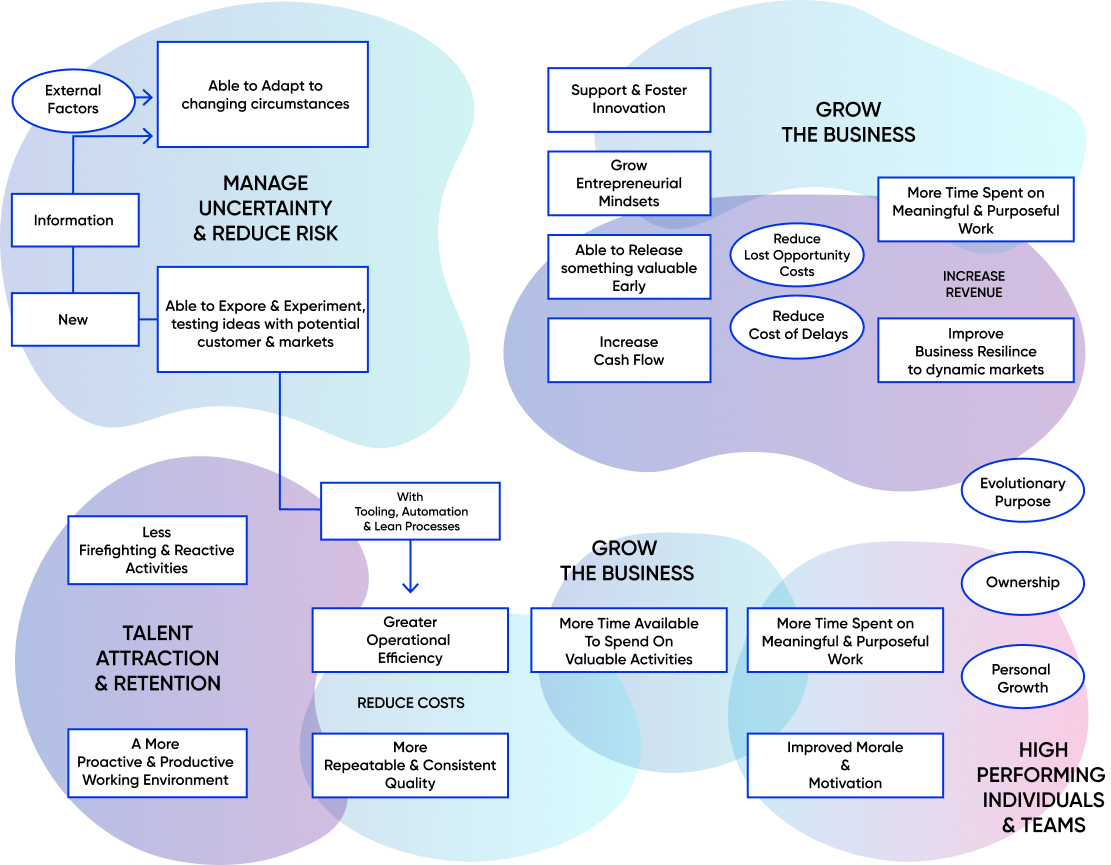Document Automation with AI: Major Challenges & Opportunities
Go beyond conventional document processing to boost the effectiveness and efficiency of your document workflows with AI and automation
download the full guideIn recent decades there have been significant advancements in automated document processing technologies, such as Optical Character Recognition (OCR) and Robotic Process Automation (RPA), that have dramatically transformed document processing operations. As organizations continue to innovate, OCR and RPA methods may no longer provide a competitive edge.
It is essential to explore artificial intelligence (AI) to augment your document processing operations further. AI-powered document processing, also known as Intelligent Document Processing (IDP), can help improve efficiency, reduce errors, and provide faster service, leading to increased customer satisfaction and improved profitability.
AI can enhance document processing; but, as any other opportunity, its adoption comes with challenges. This guide explains how to overcome them, while taking advantage of the opportunities.
Breaking Through the Limits:
Challenging Status Quo to Prioritize Business Objectives
In the digital age, leveraging AI technologies to streamline processes, achieve operational efficiency, and gain a competitive edge is a must. One such technology is Intelligent Document Processing (IDP).
Adopting AI and IDP, however, comes with a range of challenges that need to be addressed for successful implementation. Let’s discuss them in more detail.
1. Pressure from the competition
In a competitive business environment, you can start to invest in AI technologies and automation tools to streamline and scale your document processing workflows. The problem is that your competitors are probably doing the same. Therefore, not just a move to adopt but a quick and effective adoption of AI and IDP is key?
How can your organization stand out from the crowd?
Tips on successful adoption of AI and IDP:
- Start by understanding what AI is and how IDP can help your organization to achieve your business objectives. C-level executives and other key stakeholders should be on board with your IDP implementation initiative.
- Identify use cases where IDP can have the greatest impact on your organization (e.g. invoice processing, contract management, document classification). To zoom in, assess your current document workflows.
- Assess and prepare your data by cleaning, formatting, and categorizing it, to ensure that your AI models can learn from it effectively. Attract niche experts who can help developers to handle and understand your data.
- Train your AI models on a diverse range of data sets, to ensure that they can accurately recognize and classify documents of varying types, formats, and complexity.
- Once your IDP solution is deployed, monitor and evaluate its performance regularly. This will help you to identify areas for improvement and ensure that your solution continues to meet your business objectives.
- AI-powered document processing involves handling sensitive and confidential information, so it is important to ensure that your solution is secure and compliant with relevant regulations and standards.
For organizations lacking internal AI/IDP expertise and talent, it is critical to choose the right IDP vendor. Such factors as data availability, infrastructure readiness, and employee resistance to change can be addressed by an experienced provider of IDP development services.
- What is the vendor's level of expertise in developing and implementing IDP solutions?
- Does the vendor have experience in my industry or use case? Have they worked with businesses similar to mine?
- What is the vendor's track record in delivering IDP solutions? Can they provide case studies or references?
- What level of support and maintenance does the vendor provide for their solution? Is it included in the pricing, or is there an additional cost?
- What level of customization is available with the vendor's solution? Can it be tailored to my specific business needs?
- What is the vendor's approach to data security and compliance? Do they have a track record of meeting relevant regulations and standards?
- How difficult will it be to integrate the vendor's solution into my existing systems and workflows?
- What is the vendor's pricing model for their solution? Is it a one-time fee or an ongoing subscription? Are there any hidden costs?
- Does the vendor provide training and support for my team to effectively use the IDP solution?
- What is the vendor's roadmap for future development of their IDP solution? Will it continue to meet my business needs and keep up with industry advancements?
By choosing the right IDP vendor and the right IDP solution from the start, your organization will have a better chance of adopting AI-powered document processing quickly and efficiently, enabling you to withstand the pressure from the competition.
2. Low margins and high operational costs
The adoption of AI and IDP can lead to significant cost savings, increased productivity, and improved profitability. To invest in the right solution, conduct a cost-benefit analysis to determine the potential cost savings and the best ROI.
However, even after your IDP solution is up and running, you should work continually to maximize its potential for profitability and growth.
Tips on maximizing your IDP solution’s ROI:
As with any AI solution, IDP is a work in progress that needs to be continuously maintained. Do not consider it a done deal once the model(s) is deployed; this is only the beginning stage of a successful, value-driven AI project.
3. Inefficient document processing operations
IDP can significantly improve the effectiveness and efficiency of your document processing operations, end to end. Opt for IDP solutions that can enable document processing at all stages, from data extraction to document classification, to BI & Analytics.
Tips for achieving more efficient end-to-end document processing:
formats
routing
automation
extraction
accuracy
capabilities
Your organization’s ability to make IDP an integral part of your value chain is key to higher efficiency. Do not think of IDP as a tool for extracting data points from documents; instead, focus on leveraging data availability to drive efficiencies through more informed decision-making.
4. Dependency on external providers
Relying too much on external providers can be a problem. Look for IDP solutions that can provide in-house capabilities, such as customization and integration with existing systems. This can give you greater control over your document operations, and help mitigate risks associated with dependency on a third party.
Over the long run, your organization can also:
- Start to build in-house expertise with the help of your IDP vendor
- Invest in internal R&D to move away from o-the-shelf solutions to custom solutions
- Collaborate with industry partners to share datasets, expertise, and ready-to-use AI/ML models
- Use multiple vendors to reduce your dependency on a single third-party vendor
- Explore open-source solutions as an alternative to third-party vendors
Knowledge transfer is a must. Your operations and your IT personnel need to learn how to make the most out of their new AI tool. This includes the ability to manage datasets and data workflows, models and AI/ML workflows, and other integrated components. Your team may not be able to design and build a solution from scratch, but it should be able to handle its moving parts.
5. Poor user experience affecting customer satisfaction
AI-powered document processing can be a driver of customer satisfaction, enabling organizations to reduce response times and improve service delivery through faster access to document data. Because speed plays a crucial role, you should integrate your IDP solution with workflows that offer real-time customer feedback and analytics.
Over the long run, your organization can also:







6. Budget and resource uncertainty
The adoption of AI usually requires significant investment in technology, infrastructure, and training. However, such factors as lack of clarity in project scope, uncertainty in data availability, a rapidly evolving technology landscape, need for specialized talent, and other technical and operational challenges can make it difficult to calculate your budget.
Before adopting Intelligent Document Processing, it is crucial to determine your budget for adoption and invest in the right solutions that provide the best ROI.
Tips to estimate the budget of your IDP project:

document formats

document routing

workflow automation

for data extraction

improve accuracy

search capabilities
Establishing a clear budget plan for AI and IDP is not a simple task. Any AI project is a work in progress, which necessitates a certain degree of budget flexibility. To minimize budget uncertainty, look for vendors that offer flexible pricing models that align with your business needs and provide predictable costs.
7. Low business agility affecting capitalization
As with any AI adoption initiative, IDP can impact your business agility and capitalization goals, as it requires significant changes to your existing processes and workflows.
Why Create or Increase Business Agility

As is clear from the above image, there is a strong correlation between high business agility and the success of AI adoption. Companies that are able to quickly adapt to changes and implement new ideas are more likely to effectively leverage AI technology and reap its benefits, and vice versa.
Tips to minimize the effects of low business agility on business capitalization goals:
innovation
collaboration
processes
collaboration
infrastructure
structures
Your organization should also invest in AI/IDP solutions that offer seamless integration with your systems, and provide training and support to your staff.
Unlocking the Power of AI and IDP for
Enhanced At-Scale Document Processing
AI and IDP solutions can help you achieve your business goals and address your needs for more efficient document processing. Further on, we will take a closer look at the advantages that IDP can bring to your organization.

1. Addressing customer needs quickly and cost effectively
By using AI and IDP solutions, your organization can automate and streamline your document processing workflows, enabling you to meet the demands of your customers for faster, more accurate, and personalized services.
Consider these four drivers of value:
Bear in mind that data, including that which is extracted from documents, is central to any digital or AI transformation effort. Approximately 80% of business data today exists in unstructured formats like emails, images, business documents, and PDF documents.
The ability of IDP to unlock insights from any type of document means faster digitalization, more efficient AI adoption, and higher quality of BI & Analytics — all of which naturally translate into customer value.
2. Achieving business agility and scalability
Most AI solutions oer a high degree of flexibility and scalability, enabling your organization to scale your operations and adapt to new opportunities and challenges. By using AI to automate your document processing workflows, you can achieve greater business agility, to quickly respond to new opportunities and expand your operations to new markets.
Greater business agility and scalability are achieved through:
It is important to note that AI is not a silver bullet. While it can be possible to improve business agility by implementing a single AI use case (e.g. data capture, data extraction, data-to-insight), it is more challenging to scale AI across the organization, because it requires fundamental changes in IT infrastructure, operations and processes, and company culture.
3. Improving the eciency of operations
AI-powered document processing solutions can significantly improve the eectiveness, eciency, and accuracy of your operations through:
- Higher level of automation of manual tasks and processes
- Faster and more accurate processing of documents, on a larger scale
- Streamlined workflows, from digitized documents, to data extraction and conversion, to actionable insights
- Better data quality, management, and governance, which create a positive cumulative eect for AI/ML & Data Analytics projects
The operational improvements that IDP solutions deliver are massive. One example is an engineering firm that was able to cut its RFP response time from three weeks to one with IDP, and to process 400% more RFPs than it could with a sta of 80 people reading complex diagrams in documents.
Another example is a global life sciences consultancy that scaled its pipeline for processing of FDA Form 483 observations, achieving 70% accuracy in document classification. They were able to decrease the time spent on manual review, optimize processing costs, and increase accuracy and throughput of document processing while mitigating risks of infractions made by mappers and reviewers.
4. Adopting customer satisfaction as a KPI
AI and IDP can help to dramatically improve your customer satisfaction levels by delivering more accurate and personalized services, faster and at scale. Most importantly, they enable your organization to incorporate customer satisfaction as a key performance indicator for your business
Customer satisfaction KPIs to measure in document processing:





Other areas for improvement are doc ument accessibility, service personalization, and 24/7 availability. These lead to a more user-friendly experience, increasing customer satisfaction.
5. Improving document storage and usage
AI oers advanced document storage and retrieval capabilities, enabling you to more eciently manage and utilize your documents. By using IDP, you can extract valuable insights from dierent types and formats of documents, to make business-critical decisions based on data rather than on assumptions.
As seen in the above image, the document processing workflow is a journey from machine-unreadable to machine- and human-readable data. IDP solutions provide better document storage and usage capabilities, making them a major part of the value chain from data to insights.
Better document storage and usage helps with:
and indexing
routing
capabilities
In today's competitive business environment, it is imperative to take advantage of every opportunity to stay ahead. AI gives you the tools to augment document processing operations, and several challenges to AI adoption should not hinder successful implementation of IDP solutions.
Conclusion
The adoption of AI-powered document processing solutions can offer significant to businesses, but successful implementation requires that you address several challenges. Common pain points associated with IDP adoption are ranging from the pressure to implement the solution fast to inefficiencies caused by poor user experience, to various operational and budget constraints.
Businesses can proactively overcome these challenges, however, by partnering with reliable providers who specialize in developing customized solutions, tailored to meet specific business objectives.
In this guide, we looked into some of these challenges, and explained how you can overcome them while focusing on the immense opportunities AI-powered document processing can offer to your organization.
If you require further assistance, our team is available to help. Please feel free to reach out to us directly, and one of our IDP experts will be happy to answer your questions on how our IDP solution can best meet your business needs.